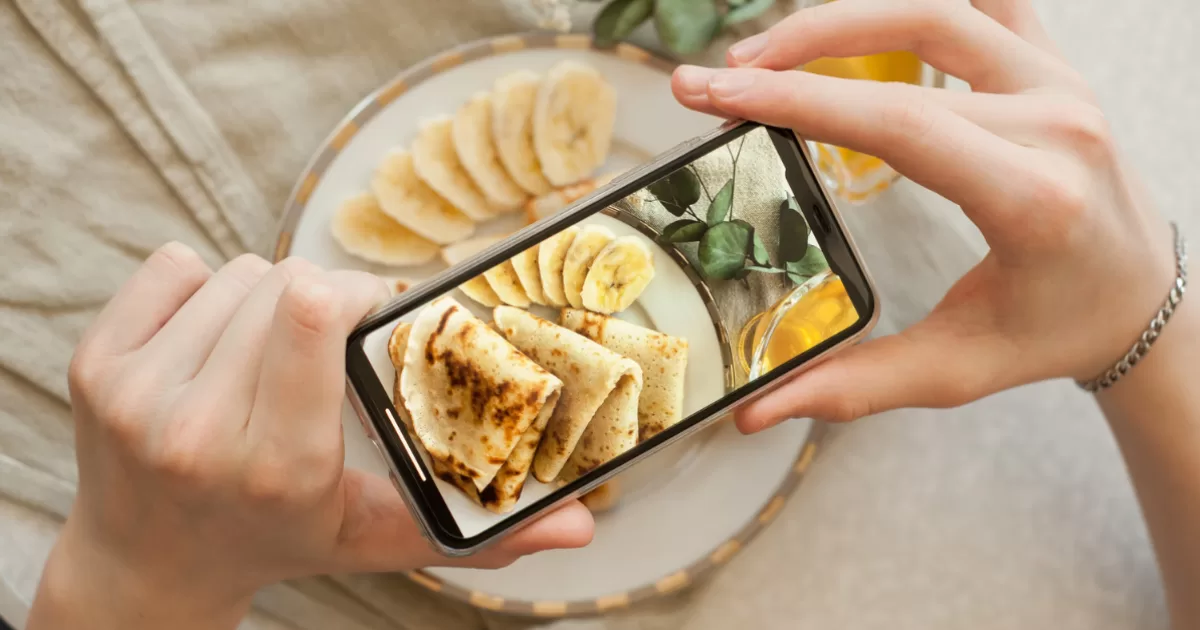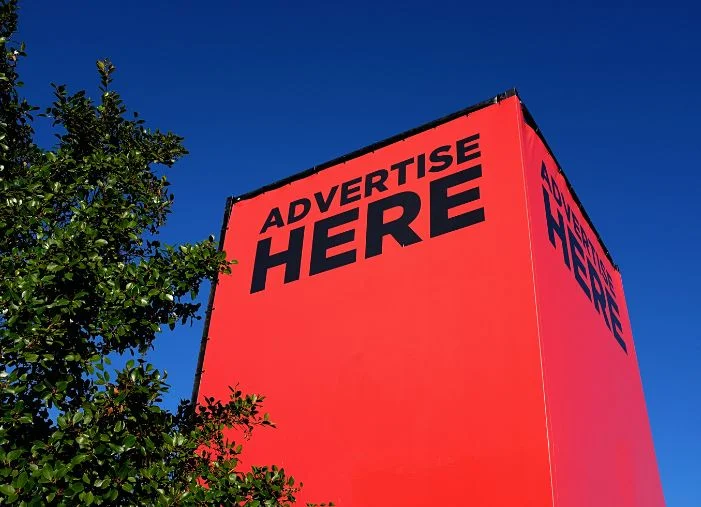There are two types of people in this world: those that love to shop, and those that hate to shop. I would say I’m more of a hater than a lover myself, but we all have to do it from time to time.
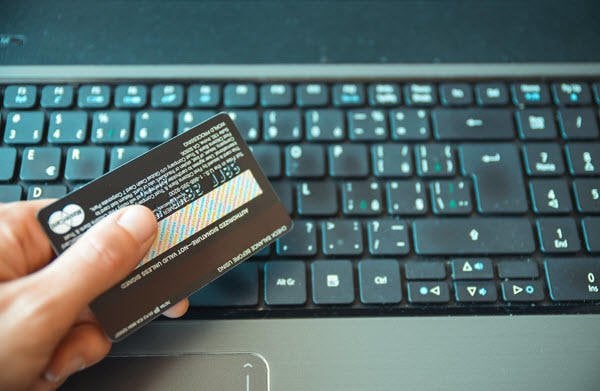
In this consumer-driven world we live in, there are messages left, right, and sideways trying to convince us to buy one product or another. This is what makes retail marketing so darn challenging. Retailers are often fighting for attention to get prospects to hit the “buy” button or come to their brick and mortar storefront and swipe their cards. And with such a big shift to ecommerce dominating the retail space, those who are managing storefronts may be suffering.
According to Big Commerce, 51% of Americans prefer to shop online, and almost everyone – 96% – has made an online purchase in their life (not surprising to me!). So if you are retailer with a store presence, how can you get shoppers to come by? The old strategies of simply having a good location or putting up flyers or ads in your local newspaper aren’t going to cut it anymore.
Well, fear not! We have 11 powerful retail marketing tips to help you increase your retail sales, both online and offline, starting with…
#1: Run Beautifully Executed Google Shopping Campaigns
With over 3.5 billion searches occurring on Google each day, it’s no secret that people use Google to shop. Between searching for product reviews and store locations and the convenience of ordering online, the most powerful search engine has become a digital shopping tour guide for most.
This is why retail marketers absolutely must be capitalizing on Google shopping PPC ad campaigns. Google shopping campaigns allow retail marketers to sell their products directly through the SERPs, so whether you have a storefront or not, these campaigns are worth investing in. While some of you readers may already be running Google shopping campaigns, here are some additional strategies to capitalize on your SERP sales…
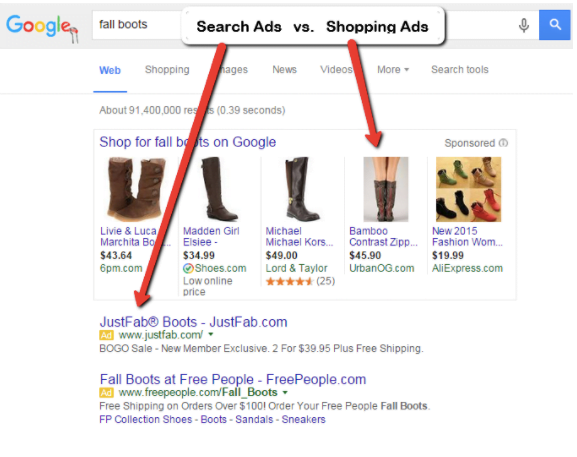
Organize Shopping Campaigns by Best-Selling Items
When you’re configuring your Shopping campaigns make sure your products of similar value are grouped together so you can easily allocate and adjust budgets in a logical manner. Grouping together your best sellers will help you capitalize on online sales.
Want a more in-depth look at Google Shopping? Download our free guide and learn how to build super profitable campaigns!
Ensure Your Ad Images are High-Quality and Crawlable
This tip might seem obvious, but you’d be surprised at how often marketers overlook the quality of their ad images, which is your first chance to grab the potential buyer. So, what makes a good quality image? One with little grain, fine detail, and a simple white background so that searchers can focus on the product that’s being sold.
It is also critical to follow Google’s guidelines when configuring your images. For instance, for non-apparel products Google advises using an image that is at least 100 X 100 pixels, and for apparel items at least 250 X 250 pixels. The image URL needs to start with http or https, and use an encoded URL that complies with RFC 2396 or RFC 1738.
For more information on specific technical requirements to ensure your images appear beautifully on the SERPs and are able to be crawled by search bots, check out this resource.
Include Merchant Promotions and Product Reviews
With retail marketing being one of the most competitive industries to be in, it could not be more critical to gain votes of confidence on your products through a sea of 5-star reviews. Of course, your products actually need to be well-received to earn these justly, but assuming you do have items on the market with great reviews, you should absolutely be showing these reviews off.
Why? Because reviews drive purchases. This isn’t revolutionary! In fact, 88% of consumers say they trust online reviews as much as personal recommendations. So, how can one take advantage of reviews within their shopping campaigns? Here are a couple ways…
- Utilize Merchant Promotions: This will allow you to add tags like “Special offer” to your shopping ads. Set-up requires a few steps including filling out the merchant promotions interest form and either using the +PROMOTION tool or setting up a promotion feed. Follow the steps here to get your promotions approved.
- Configure Product Ratings: You’ve all seen the little star rating underneath products on the SERPs. Don’t you want these for your ads? You need to gain at least 50 reviews on one of Google’s third-party approved sites to ensure the reviews show. Check out the approved third-party sources here, where you should be actively seeking reviews to ensure they appear in the SERPs.

#2: Give Shoppers a Reason to Visit Your Store
Currently I’m cozied up in my pajamas in my South Boston condo watching as another New England snowstorm buries me into my couch even further. Do you really think I’m trekking through the snow to make a purchase in your storefront while I could just browse for a similar product on Amazon Prime, and have it at my doorstep by tomorrow afternoon?
The convenience of online shopping has been hard on many retail marketers operating physical storefronts. Yet, many still do prefer shopping for items in person because you have the ability to see and touch items and try things on without going through the hassle of shipping back items that don’t fit.
Unfortunately, these benefits alone aren’t always enough to get customers to leave their Netflix at home. So, what to do? Well, retail marketers desperate for more storefront traffic need to start giving their customers a reason to come in. Perhaps you have a special in-store discount for shoppers. Lululemon is constantly convincing me to come by their stores with their free yoga classes. Check out the Facebook post below.
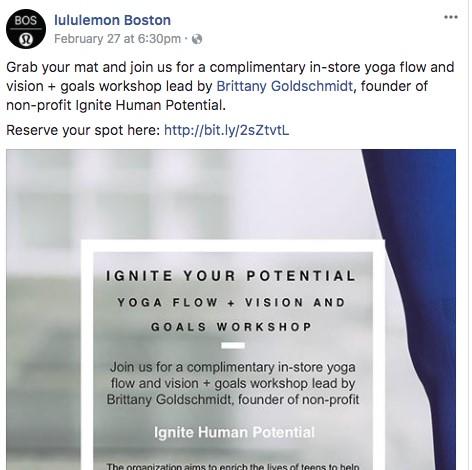
What a great way to incentivize shoppers to come into the store for a free and very on-brand offering, where they then will of course be surrounded by all of the tempting new yoga clothes for sale. You should try the same, and make sure to promote your offerings on your social networks to spread the news.
#3: Use Social Media Targeting Capabilities to Your Advantage
You likely already have some form of social media presence, but if you haven’t yet invested in the world of social media advertising you are surely missing out. Why? Because platforms like Facebook, Instagram, and Twitter make it absurdly easy to find and get in front of the people most likely to buy your products.
Let’s run through an example to see how detailed you can actually get. Let’s say you sell wedding dresses in the city of Boston. You have a pretty clear idea of who your target audience is based on your product and the prices of your dresses so you decide to configure a campaign. You start off my targeting women, who make up 99.9% of your customer base. Then you set up the age ranges between 24 and 40 years old, since the style of your dresses cater most to this age range.
Next is location – you type in the zip code to show your ads to Facebook visitors in a 25-mile radius. Are you set? Actually, no. You can dig into various categories and sub-categories to target engaged shoppers, interested in marriage, weddings, women’s clothing, and dresses. Perhaps you narrow your audience even more by targeting friends of people who already liked your page.
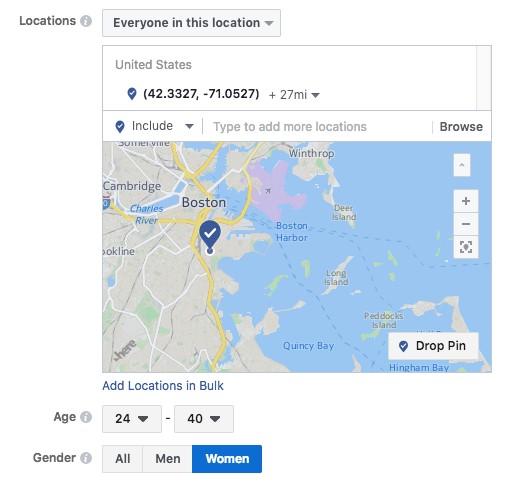
Basically, the possibilities are quite endless with the detailed targeting you can do so make sure to get on these platforms to start reaching your audience faster on social!
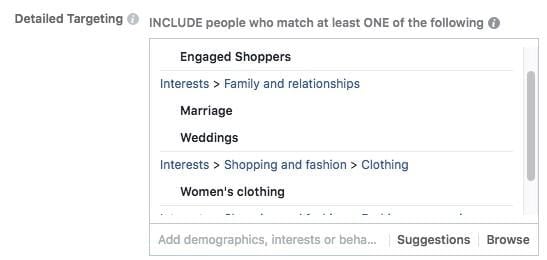
#4: Don’t Forget to Be Locally Relevant
Whether or not you are operating a retail storefront, if you can be locally relevant to each audience this is going to help your chances of winning them over. People want to feel like they’re part of their community, and if your brand blends in seamlessly with their home then they are more likely to draw an emotional attachment to your business.
There are a few key ways to ensure you’re being as locally relevant as possible…
Geotargeting
I touched on this a bit in the tip above, but the more granular and local you can get with your targeting, the easier it will be to appear locally relevant. Use geotargeting on platforms like Google Ads (formerly known as AdWords), Youtube, Facebook, Twitter, etc., to reach the locals.
Ad Copy and Imagery
Fill your ad copy and images with local appeal – for example, by taking product shots in scenic local parks or even selling local products. Take this example from a design and décor shop in Southie called Neatly Nested. They designed a Southie mug for locals to enjoy, and it was such a hit that they had to order more!
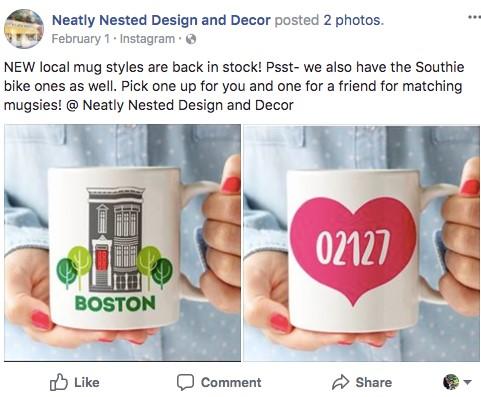
Use Local Lingo
It’s wicked cold out there today, am I right? Every locally born Bostonian uses “wicked” in replace for “very” in every other sentence. It’s just what we do. Are their certain phrases that only locals use? Fill your ad copy with this type of language to make your potential buyers feel at home.
#5: Invest in Some Guerilla Marketing Campaigns
Do you ever think about taking a step outside of the digital world to explore how your physical surroundings could help you market to your ideal audience? Guerilla marketing is just that: leaving the screen behind, and using public places to get the word out about your business. While marketers definitely cannot rely solely on guerilla marketing, it can be a great way to boost your store’s visibility in a fun and creative manner.
We’re all exposed to guerilla marketing campaigns in our daily lives whether we realize it or not, which is why creativity is key. Think of it like ambush marketing, but a little different. Take this example from Unicef, where they installed dirty water machines to spread their social cause to the general public.
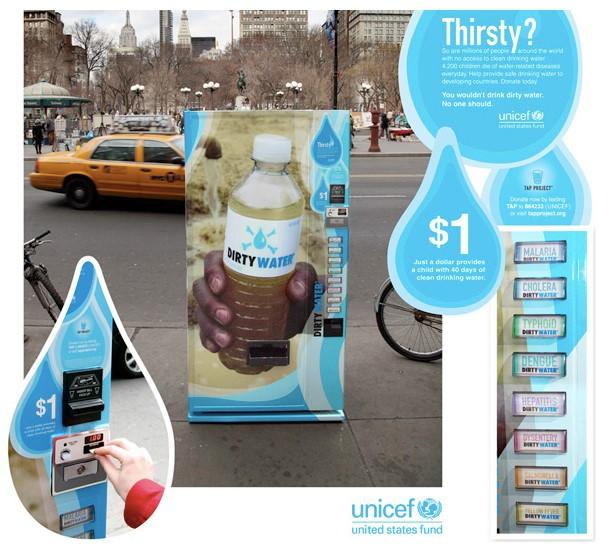
Pretty powerful, but expensive… Luckily, these campaigns don’t always need to cost an arm and a leg. Partner with a friend to open up a pop-up shop in their space, or create a gorgeous mural to boost your brand name.
So put your creativity cap on and think outside of the box to grab the attention of the public outside of the internet. It will be far more memorable!
#6: Try Podcast Advertising
What is your audience listening to? The podcast trend has continued to grow at a steady rate year after year. In fact, 67 million Americans listen to podcasts monthly, which is a 14 percent year-over-year increase.
The great thing about podcasts is that there are so many in niche industries, so based on what you’re selling, and more importantly who you’re selling to, you can select the right podcast to pursue. Once you have discovered your audience’s choice of podcasts, invest in running some advertisements to sponsor the commercial breaks. This works incredibly well since listeners are typically driving or commuting to work and skipping these ads isn’t really an option.
#7: Get Creative with Video
There’s no better way to bring your products to life than with video, whether it be a simple video showing the fit of your clothing or something a bit more creative that involves an emotional storytelling component. There is so much room to create an experience that really resonates with your audience, and make your brand unforgettable in their eyes.
In fact, some brands have made their products big through video. For instance, who could forget the Dollar Shave Club videos then went viral? These videos worked remarkably well because they showcased their products, but with an entertainment element that made the brand unforgettable (and made viewers actually want to try their razors!).
Another great example is this video from Man Crates:
#8: Celebrate All the Little Holidays
If you haven’t noticed there is a national day for everything – from pancakes to siblings to candy corn, these fake holidays have taken over. And don’t worry, I’m not suggesting that your brand celebrate every one of these “holidays,” but it is worth celebrating days that are particularly relevant to your retail offerings, as well as holidays like Valentine’s Day and Saint Patty’s Day. When you embrace these days, release special limited-edition products around them (Shamrock shakes!), run special events, or offer deals in festive holidays colors, it gets people excited.
Check out this Valentine’s Day post, again from the small retail store Neatly Nested, for example. Not only do they showcase an adorable plate you could purchase, but they encourage customers to stop by and check out a special floral pop-up.

#9: Instill a Sense of Urgency
Have you ever made an impulse buy? I’d be willing to bet that this decision was fueled by a sense of urgency.
When you instill urgency into your marketing messaging, your audience feels the pressure and is more likely to give in and make the purchase now. This is why running short-term discounts and deals while being fully transparent on when they end is going to help drive more retail sales.
Take this example from an email I recently received from the online retailer Fabletics. Not just one, but TWO pairs of leggings for only $24! That’s a pretty awesome deal. The problem is the deal ends on Monday, so tempted shoppers know they need to get a move on or else they will be stuck paying full price when they need new workout gear.
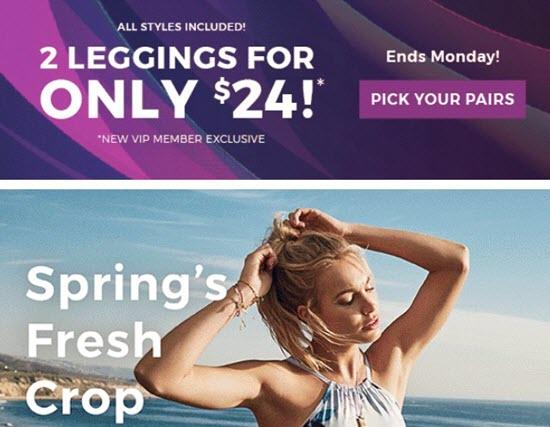
#10: Understand Your Seasonal Peaks and Plan Accordingly
Retail marketers are hopefully already aware of their business’s seasonal peaks. Whether it’s summer sales, Black Friday, or holiday peaks, retailers need to plan their campaigns FAR in advance of these seasonal peaks.
This includes things like adjusting ad spend, working with design for new creative, and executing seasonally relevant campaigns that will boost sales during these peak times. Planning is absolutely key for these peak times because competition is typically steeper, so upping spend and using ad scheduling tools to save time and not let thing slip through the cracks is critical.
If you’re new to your retail job and not quite sure what the seasonal peaks are for the business, head over to Google.com/trends where you can search various categories and keywords and analyze the seasonal peaks that are on brand. For example, in the below shot you can see that the online retail market for “notebooks” peaks in mid- to late August (unsurprisingly, right before the schoolyear starts).
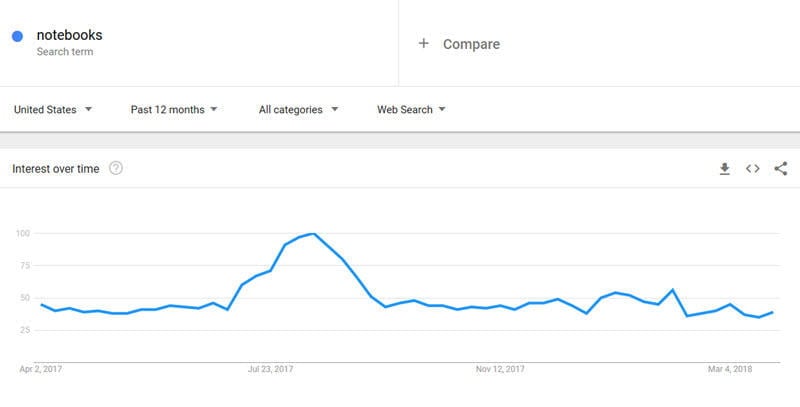
#11: Create Returning Buyers through Smart Remarketing
Every industry should be remarketing. Why? It just works. Remarketing allows you to remind shoppers that they should buy your products. But there are strategic ways to get even more profitability out of remarketing in retail.
In the retail space, value is not typically gained from one-time buyers, but rather regular customers who keep coming back for more. The problem is your shoppers are busy and easily distracted. They might forget how positive their online experience was with your brand if you don’t remind them. This is why you need to be smart with remarketing tactics that will re-engage a previous shopper at the right time.

A retail remarketing ad tempting me to buy more perfume
Think about the lifespan of your product. For example, do you sell facewash? How long does a bottle typically last? If it’s two months, then run a remarketing campaign targeting previous consumers after 50 or so days of purchase to remind them to order more before they run out.
Another remarketing tactic to create repeat buyers is to upsell them based on products they’ve previously purchased. For example, if a shopper buys facewash then remarket to them the moisturizer that goes along with it. Having a knowledge of which products complement each other will help with this strategy.
Now go forth and encourage your audience to shop more with these retail marketing tips!


